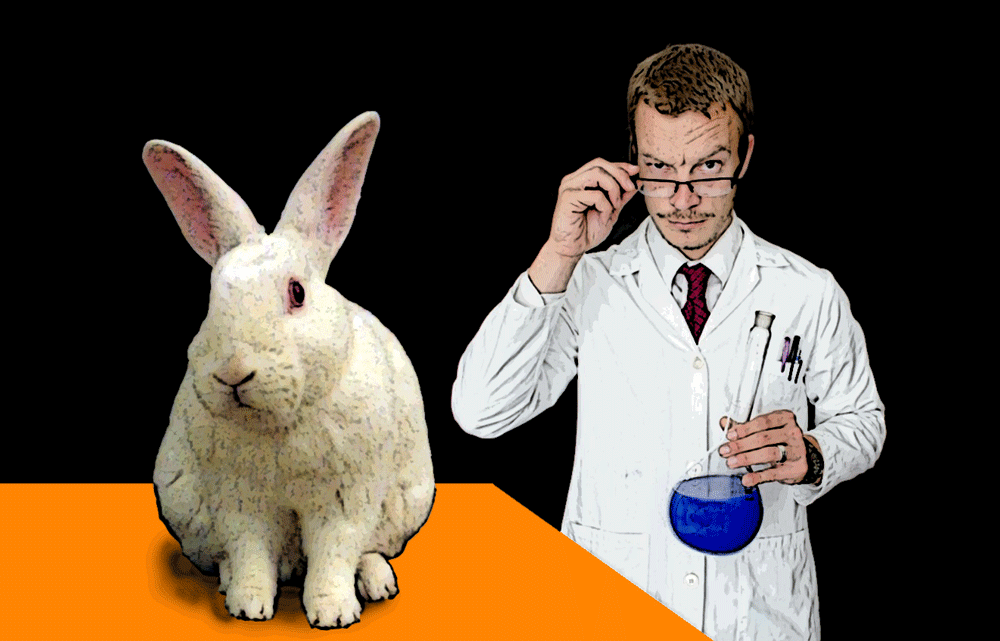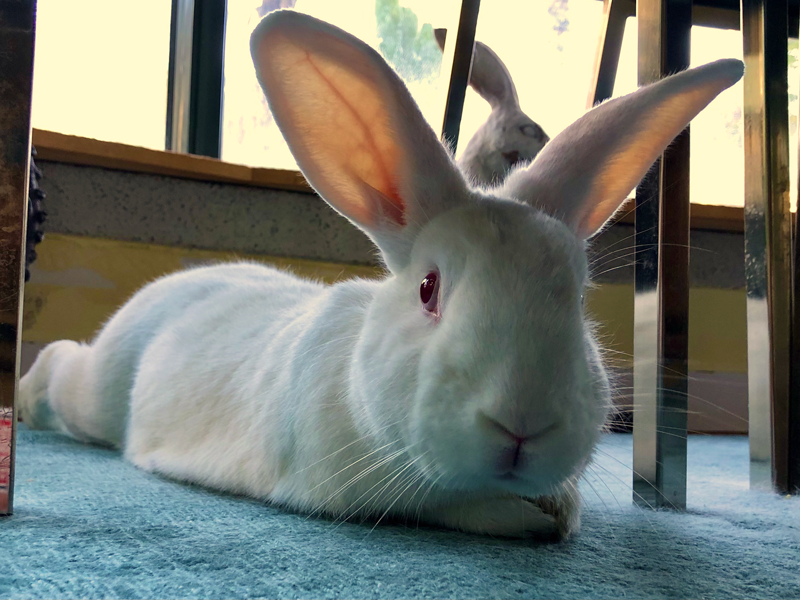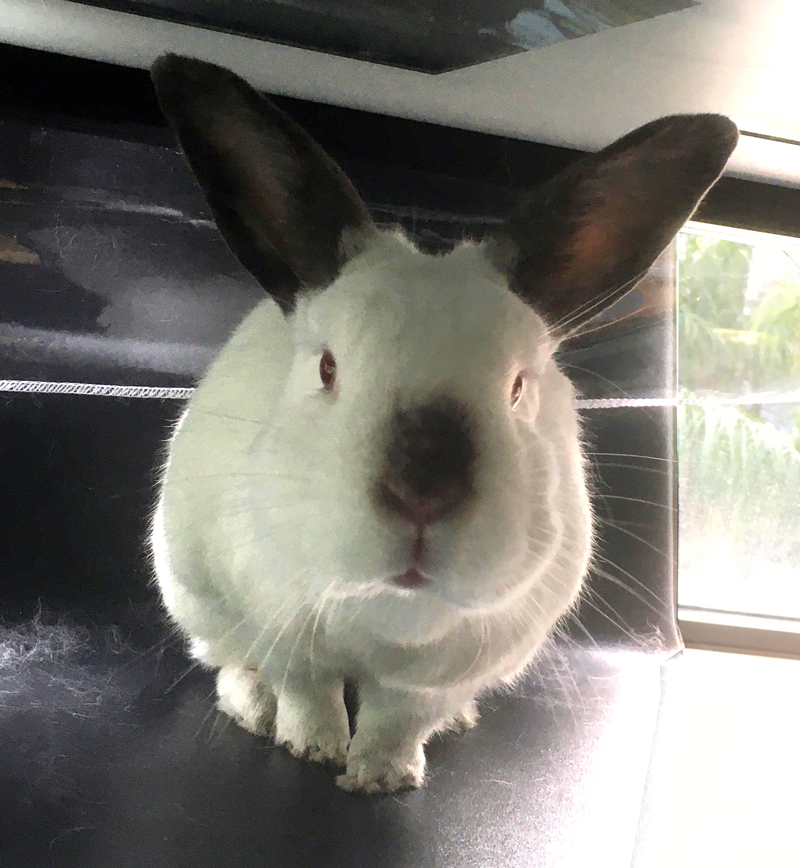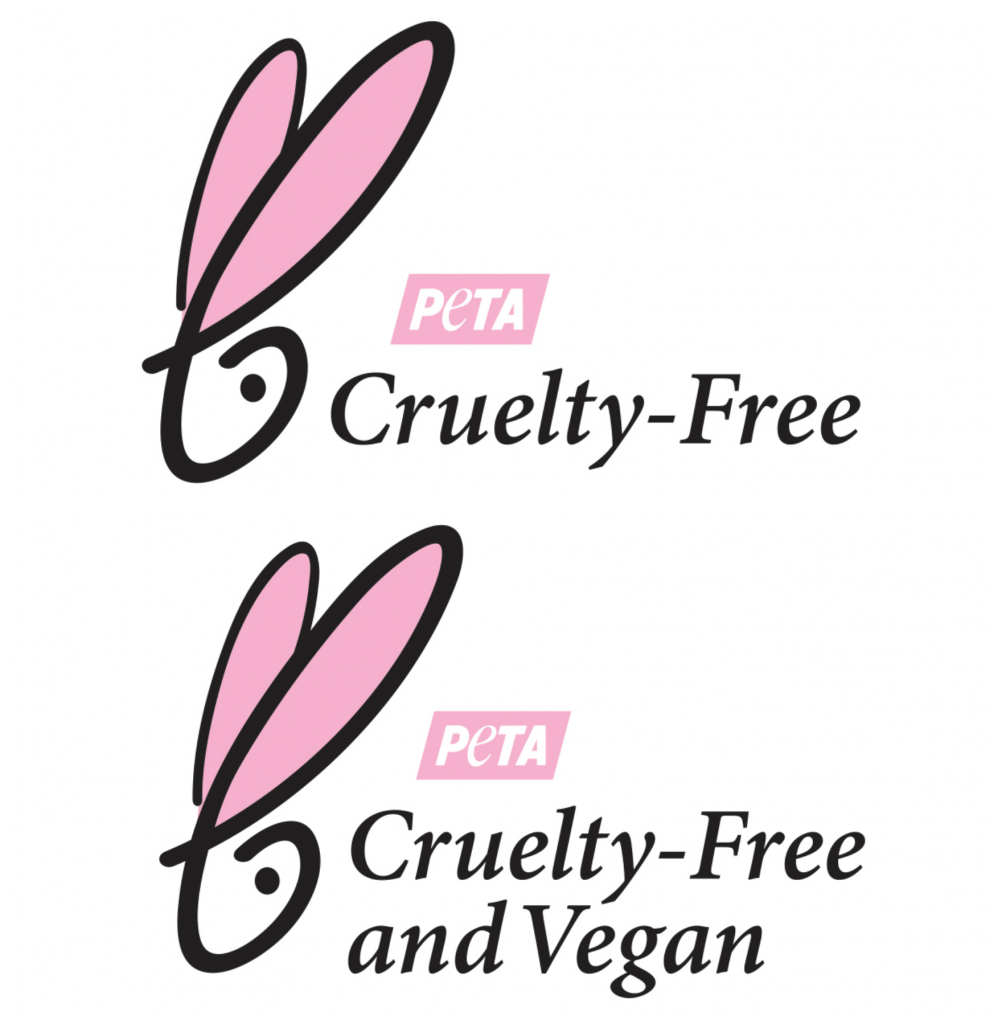
Recent headlines got me Googling about cosmetics testing on rabbits. What I found was disturbing, to say the least. I didn’t realize how horrific the test procedures are, or that test subjects are slaughtered afterwards. Though several countries have banned cosmetics testing, the U.S. still hasn’t. However, there’s at least some good news to report.
A Late Epiphany
Like many people, I’ve trusted that my government regulates businesses to ensure they make products safe without unnecessary cruelty. I pictured bunnies in the sorts of habitats used at municipal shelters, being well cared-for with the exception of occasional drops squirted in their eyes, then released after a few weeks. I didn’t like it, but I wasn’t haunted by it.
As it turns out, I was fooling myself. I’d go into more detail about what’s done to rabbits for the sake of testing cosmetics, but I don’t want to give you nightmares. The descriptions and photos make me want to grab Finnegan and wrap my whole body around him as if I could magically protect every ruby-eyed snowball of a bunny in the world by doing so. (But it would only freak the little guy out, so I won’t.)

Yes, typically it’s sweet, docile ruby-eyed buns exactly like Finny who get subjected to the pain, suffering and terror of these tests. It breaks my heart. Why use rabbits?
-
-
- They’re cheap and easy to breed and feed
- They are generally easy to handle (Far-from-docile Moraea would probably not be selected. I picture her giving them what-for in a firestorm of claws and teeth — and I love her for that.)
- They don’t have tear ducts to wash irritants out of their eyes
-

If you aren’t yet convinced cosmetics testing is something to be concerned about, read this article about the Draize test in Scientific American. Then ask yourself if our desires to look more beautiful, pamper our skin and hair, and create a more youthful appearance really justify what’s done to these defenseless, timid animals.
What’s more, the Humane Society argues that animal testing is no longer necessary. There appear to be three alternatives to using animal tests:
- Stick to known-safe ingredients
- Use one of dozens of available non-animal test methods
- Leverage sophisticated computer models that simulate human cell reactions
Why Do Companies Still Do this?

Because cosmetics testing is so inherently repellent and unnecessary, most companies now shy away from doing it — or at least from admitting they do. Perhaps it would have been abandoned entirely by now were it not for one glaring fact: The Chinese government still requires it for cosmetic products sold in their country.
A lot of makeup brands pledge never to test on animals, but if you read the fine print they add “except where required by law.” If they’re selling in China, they’ve been dancing around the fact that their products are being tested on little Finnegan look-alikes. They often pay third parties over there to do it on their behalf.
To determine if a brand is culpable or not, you can easily check on PETA’s web site , or the Leaping Bunny Shopping Guide. When I did I discovered that one of my favorites, Urban Decay, is qualified to sport PETA’s Cruelty-Free Logo, but was dismayed to learn some of my other cherished brands are not. I’ve started trying out alternative products. I want to put my lipstick money where my mouth is.
How to Build a Cruelty-Free World?
Efforts are underway to make the cosmetics industry a kinder, gentler one. The EU, India, Taiwan, South Korea, New Zealand, Australia, Guatemala, Switzerland, Colombia, Iceland, Israel, Norway, Turkey, the U.K., and ten states in Brazil now prohibit animal testing .
Although the U.S. hasn’t made it illegal, my state has. Indeed, California was the first U.S. state to do so, in 2018, followed by Illinois and Nevada in 2019, and Virginia just last March, 2021.
There’s also a contingent in the U.S. Congress that’s trying to get cosmetics testing on animals banned across the country. A bill put forth by Rep. Don Beyer (D VA) back in 2015 with bipartisan sponsorship would do just that… but obviously it has gotten nowhere. Fellow U.S. readers: if you want to do something to help move this along, I suggest writing your local representative in support of the Humane Cosmetics Act. It’s pretty easy to do online. Most reps have contact forms which you can locate using the Find Your Representative page on house.gov. Faxzero.com also offers a free service you can use to send a fax to your representative’s office using your computer or mobile device.
The Canadian Parliament has also been grappling with the animal testing issue since 2015 but hasn’t succeeded yet. Just last month, Mexico also started working to ban the tests.
What’s In a Ban?
If animal tests are federally prohibited will all U.S. companies have to stop having their products tested in China? Well, I’m no expert in the legalese that lawmakers use to write their bills, but the way I read the proposed U.S. law the answer is no. In fact, there are plenty of exemptions stipulated in the bill in addition to the one for “animal testing conducted outside the United States in order to comply with a requirement from a foreign regulatory authority.” The law itself seems unlikely to make any current animal testing illegal. In actual practice it’s more like an official statement of distaste than a ban.
There’s no denying the facts: China’s a big market and companies will always want a piece of the business it can offer. But as consensus grows around humane methods for certifying cosmetic safety, surely one day that country will stop requiring cruelty for beauty. Declaring bans on animal testing at the national level across the world is a way of expressing that consensus.
Shifting our buying towards companies that are truly cruelty-free also helps. If it provides a competitive advantage, more cosmetics manufacturers will be motivated to stop selling in China, further increasing pressure on that government to change its laws.
In fact, the actions taken so far by legislators and consumers may have already had an impact. On May 1, animal testing laws in China were relaxed. Though the new regulations are complicated and leave many requirements in place, far less testing will be needed in the future. It can now stop for makeup, skincare, nail polish, perfume, and most hair care products, so long as they’re
- not aimed at children and
- don’t contain any ingredients that haven’t previously been tested.
If you’re interested in all the details, The Ethical Elephant created a great infographic that really helps sort them out.
The Fluffy Tail of This Blog Post
Animal testing for cosmetics is more abhorrent, widespread, and ongoing than I ever imagined. I’m convinced such practices need not and should not be undertaken for the sake of human vanity. From now on, I’ll be voting at the ballot box and with my wallet to end it permanently.
Man in lab coat in featured image was supplied by PublicDomainPictures from Pixabay

Syl says:
So sad to think of animals being used for experimentation, especially for something as trivial as cosmetics.
I knew monkeys and rats were used, but I didn’t know that rabbits were at risk too.
Melinda says:
Sadly, yes. Poor sweet little things – rabbits, monkeys or rats! they don’t deserve it! Hopefully it will end soon.
Claire Thompson says:
Animal testing is outdated
Melinda says:
Thank you for the comment! yes, it’s high time we used newer methods to test product safety.
beverley evans says:
its unnecessary cruelty test on a human instead its so cruel
Melinda says:
Thank you for the comment. You’re right, or better yet there’s lots of alternatives that don’t involve any living creatures suffering!